Step-by-Step Guide to Creating a Responsive Navigation Bar with HTML and CSS
 Aditya Gadhave
Aditya Gadhave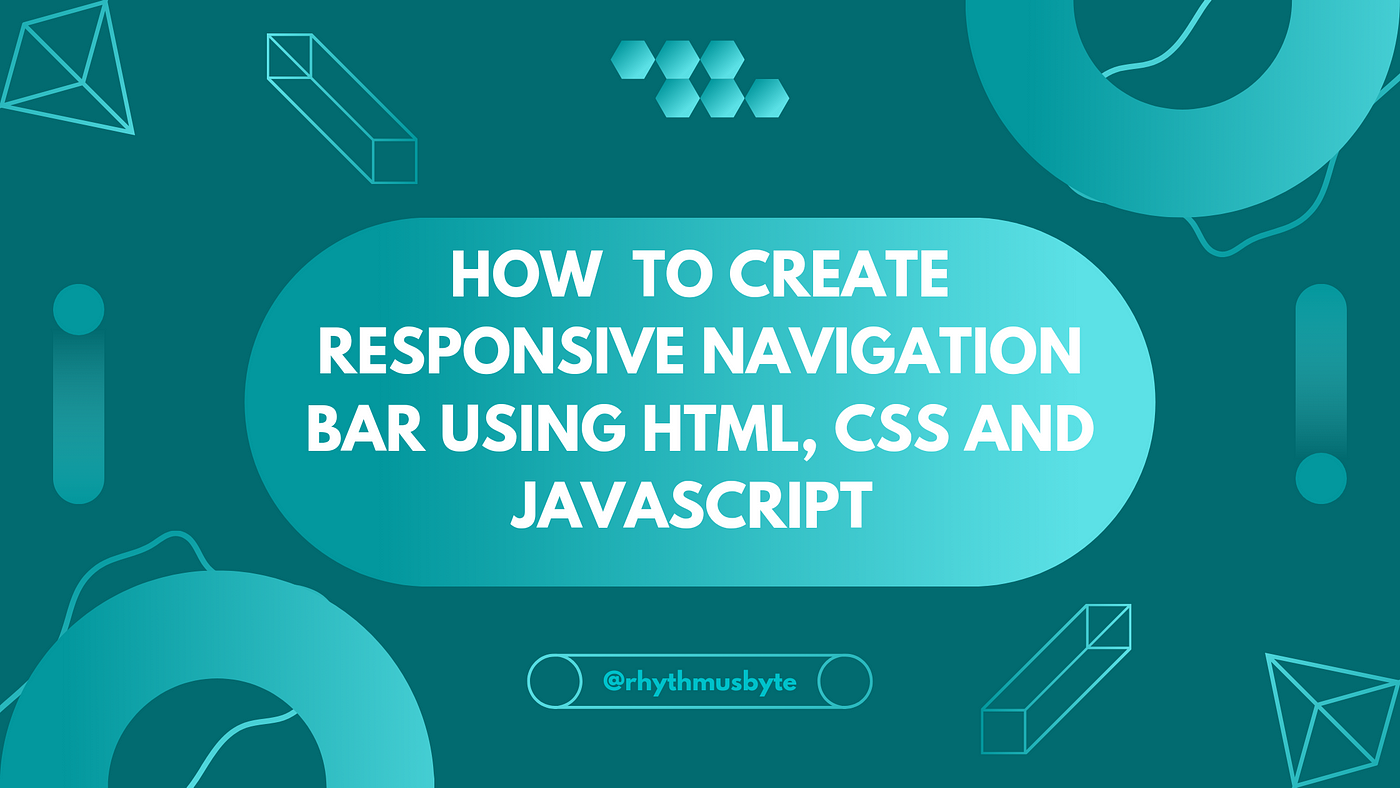
A responsive navigation bar (navbar) is essential for improving your user experience and web design skills.You've arrived at the right place, especially if you're a beginner learning front-end development and looking to build a responsive navigation bar. But before you start creating a navigation bar with HTML and CSS, you need to understand the basic design principles of a responsive navbar.
Here's how to make a responsive navigation bar using only HTML and CSS, without using even a single line of JavaScript.
Prerequisites: The Three Key Elements of a Responsive Navbar
It’s quite obvious that most website owners want to acquire new visitors. The first step towards doing so is showing visitors a clear and concise path. You should build a navbar that inspires curiosity and attracts visitors simultaneously. Consider three key elements while designing an ideal HTML navbar:
1. Simple
It should be clear and easy to read. Instead of cluttering the navbar with links to every page, you should go for the broader categories of your site. Afterward, you can add sub-menus as a dropdown, if necessary.
2. Noticeable
A simple responsive navigation bar shouldn’t be boring at all. You should stick to a pre-decided brand color to make the design more consistent. You can experiment with color schemes and use lighter or darker shades for highlighting and dropdown menus.
3. Responsive
A global internet usage report by Statista shows that 59.5 percent of the global population is actively using the internet, and 92.6 percent are using it via mobile devices. That's enough to understand the importance of implementing responsive mobile navigation on your site.
Top-level mobile navigation is quite popular. You can use a hamburger menu, guillotine, floating icons, and tabs. It’s a savior when you have five or more categories with multiple hierarchies. Top-level navigation can save significant screen space, especially with a content-heavy site.
Tab bars with relevant icons fit perfectly at the bottom navigation bar as they usually contain three to five menus at the same hierarchy level. Sub-menus and sequential menus follow the main category with the parent-child relationship.
If you are new to the world of web design, you should always consult some relevant, responsive web design principles for more tips.
Building a Responsive Navigation Bar With Hamburger Menu
Now that the design principles are clear, it's time to start building your exclusive responsive navbar menu. There are a variety of CSS features for building responsive websites. However, this guide will teach you how to create a responsive navigation menu with CSS Flexbox and Media Queries from scratch.
So, what will your CSS navbar look like? It’ll have top-level navigation with:
Logo
Navigation Menus
Dropdown Menu
Hamburger Menu (using the checkbox hack)
Getting Started With HTML :
<!DOCTYPE html>
<html lang="en">
<head>
<meta charset="UTF-8" />
<meta http-equiv="X-UA-Compatible" content="IE=edge" />
<meta name="viewport" content="width=device-width, initial-scale=1.0" />
<link rel="stylesheet" href="style.css" />
<title>Document</title>
</head>
<body>
<nav class="navbar">
<!-- LOGO -->
<div class="logo">MUO</div>
<!-- NAVIGATION MENU -->
<ul class="nav-links">
<!-- USING CHECKBOX HACK -->
<input type="checkbox" id="checkbox_toggle" />
<label for="checkbox_toggle" class="hamburger">☰</label>
<!-- NAVIGATION MENUS -->
<div class="menu">
<li><a href="/">Home</a></li>
<li><a href="/">About</a></li>
<li class="services">
<a href="/">Services</a>
<!-- DROPDOWN MENU -->
<ul class="dropdown">
<li><a href="/">Dropdown 1 </a></li>
<li><a href="/">Dropdown 2</a></li>
<li><a href="/">Dropdown 2</a></li>
<li><a href="/">Dropdown 3</a></li>
<li><a href="/">Dropdown 4</a></li>
</ul>
</li>
<li><a href="/">Pricing</a></li>
<li><a href="/">Contact</a></li>
</div>
</ul>
</nav>
</body>
</html>
Output:
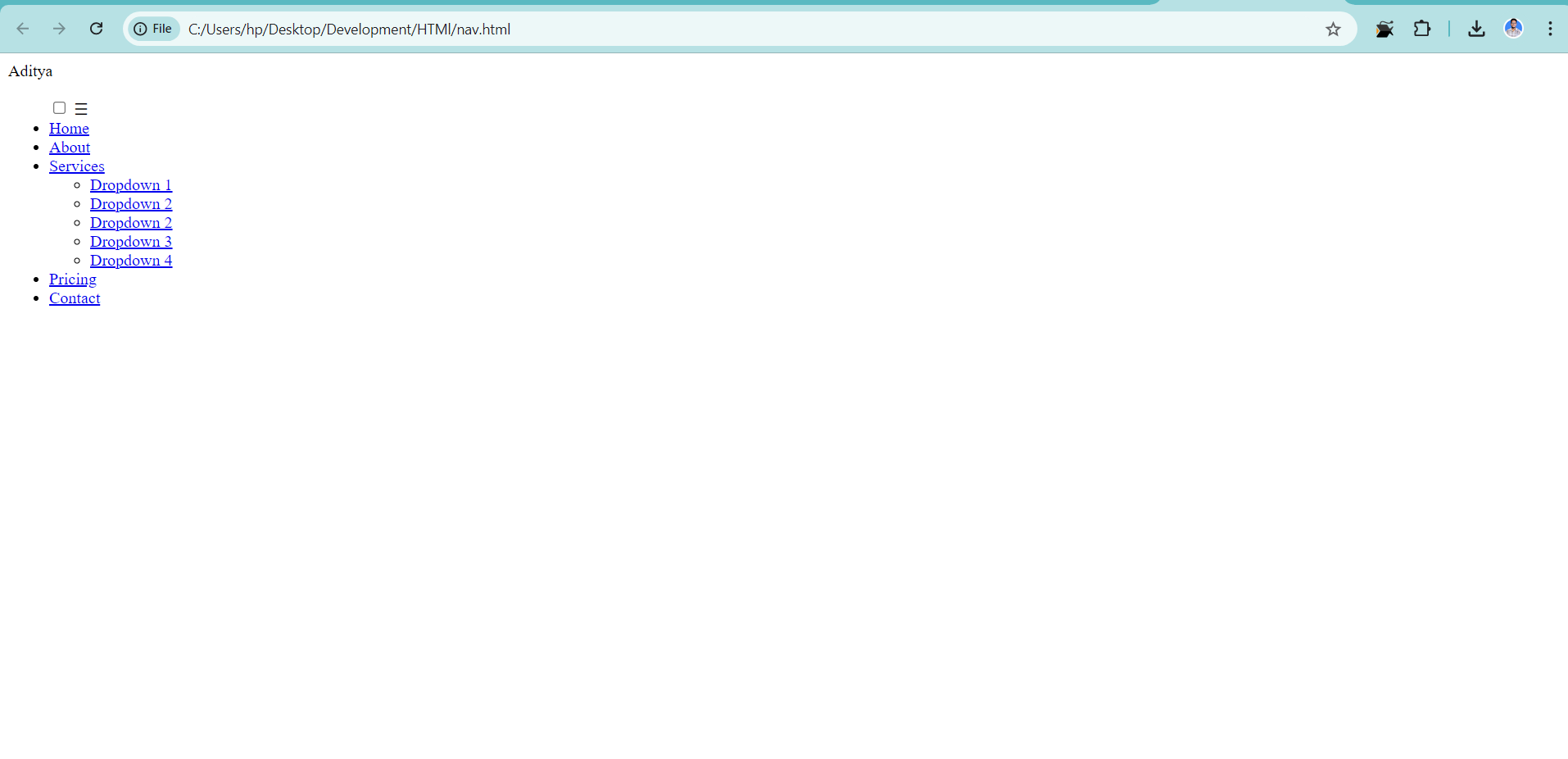
Applying Basic CSS:
/* UTILITIES */
* {
margin: 0;
padding: 0;
box-sizing: border-box;
}
body {
font-family: cursive;
}
a {
text-decoration: none;
}
li {
list-style: none;
}
Styling the Navbar Using CSS Flexbox
You can use CSS Flexbox to apply hovering effects for highlighting. The Service menu needs a little extra attention as you have to set display: none; for normal conditions and set it to display: block; when someone hovers on it.
/* NAVBAR STYLING STARTS */
.navbar {
display: flex;
align-items: center;
justify-content: space-between;
padding: 20px;
background-color: teal;
color: #fff;
}
.nav-links a {
color: #fff;
}
/* LOGO */
.logo {
font-size: 32px;
}
/* NAVBAR MENU */
.menu {
display: flex;
gap: 1em;
font-size: 18px;
}
.menu li:hover {
background-color: #4c9e9e;
border-radius: 5px;
transition: 0.3s ease;
}
.menu li {
padding: 5px 14px;
}
/* DROPDOWN MENU */
.services {
position: relative;
}
.dropdown {
background-color: rgb(1, 139, 139);
padding: 1em 0;
position: absolute; /*WITH RESPECT TO PARENT*/
display: none;
border-radius: 8px;
top: 35px;
}
.dropdown li + li {
margin-top: 10px;
}
.dropdown li {
padding: 0.5em 1em;
width: 8em;
text-align: center;
}
.dropdown li:hover {
background-color: #4c9e9e;
}
.services:hover .dropdown {
display: block;
}
This CSS will create a nav bar that looks like the following:
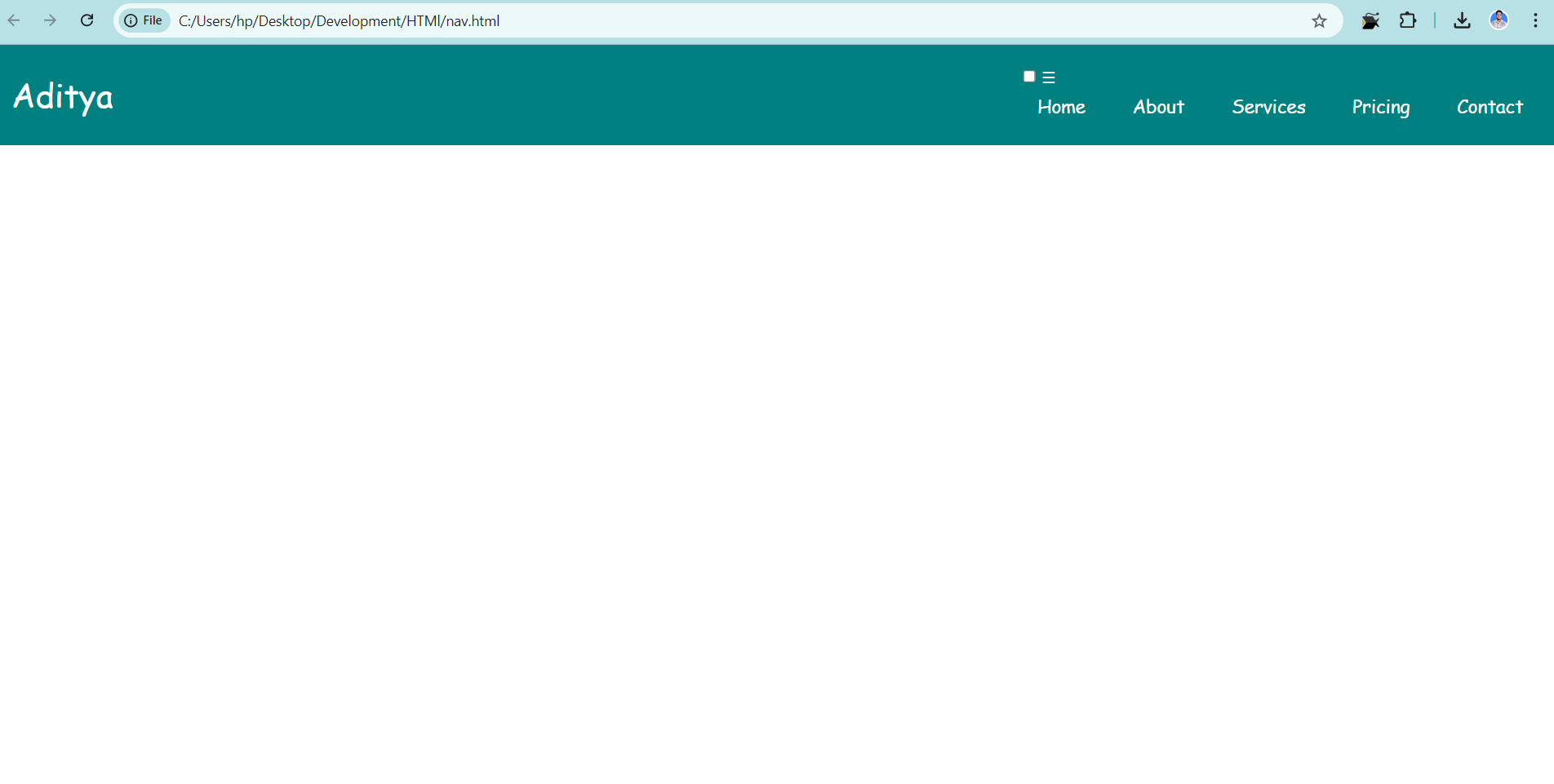
Responsive Navbar Using CSS Media Queries
Once you input this code snippet, you’ll have a hamburger menu that shows up only on mobile devices with small screen sizes. For this, you’ll have two children of <ul class="nav-links">. First, you’ll use input type="checkbox" and give the label a class="hamburger". Second, give your navigation menu class="menu".
Note that ☰ is an HTML entity that displays the ☰ character, representing a hamburger icon.
<body>
<nav class="navbar">
<!-- LOGO -->
<div class="logo">MUO</div>
<!-- NAVIGATION MENU -->
<ul class="nav-links">
<!-- USING CHECKBOX HACK -->
<input type="checkbox" id="checkbox_toggle" />
<label for="checkbox_toggle" class="hamburger">☰</label>
<!-- NAVIGATION MENUS -->
<div class="menu">...</div>
</ul>
</nav>
</body>
The logic behind using the checkbox element is that when it's unchecked, it'll have display: none; whereas while checked, it'll change the CSS property of the general sibling selector (~) by setting it to display: block; Simply stated, you’re using the checkbox to toggle the hamburger and navigation menus between the expanded and hidden states.
Style the CSS navbar for mobile devices using CSS media queries, as shown below. In this case, you can also use CSS grid and JS for the mobile menu.
/* RESPONSIVE NAVBAR MENU STARTS */
/* CHECKBOX HACK */
input[type=checkbox] {
display: none;
}
/* HAMBURGER MENU */
.hamburger {
display: none;
font-size: 24px;
user-select: none;
}
/* APPLYING MEDIA QUERIES */
@media (max-width: 768px) {
.menu {
display:none;
position: absolute;
background-color:teal;
right: 0;
left: 0;
text-align: center;
padding: 16px 0;
}
.menu li:hover {
display: inline-block;
background-color:#4c9e9e;
transition: 0.3s ease;
}
.menu li + li {
margin-top: 12px;
}
input[type=checkbox]:checked ~ .menu {
display: block;
}
.hamburger {
display: block;
}
.dropdown {
left: 50%;
top: 30px;
transform: translateX(35%);
}
.dropdown li:hover {
background-color: #4c9e9e;
}
}
Here’s what your design will look like on a desktop browser:
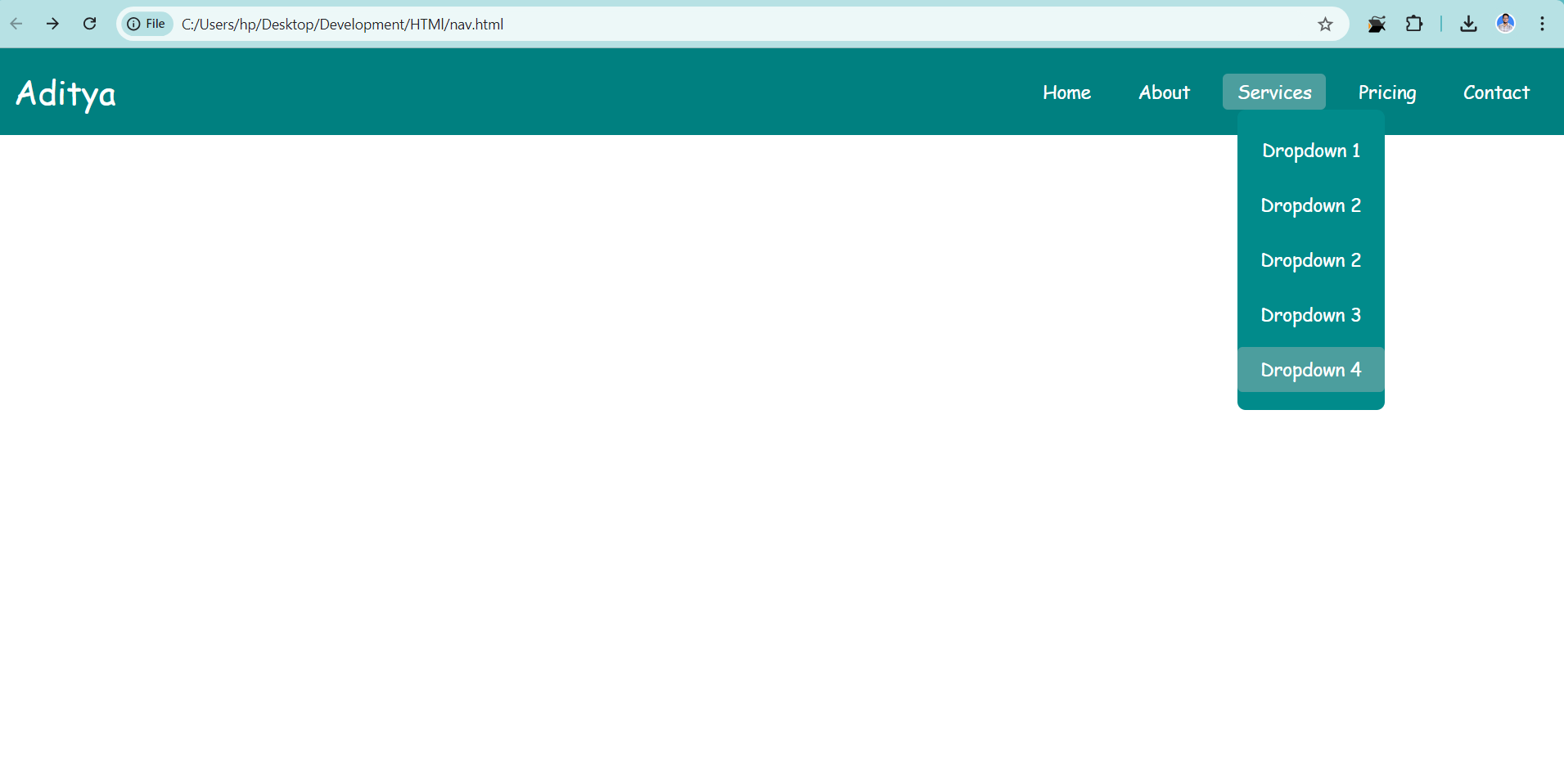
And here’s how it will display on mobile screens:
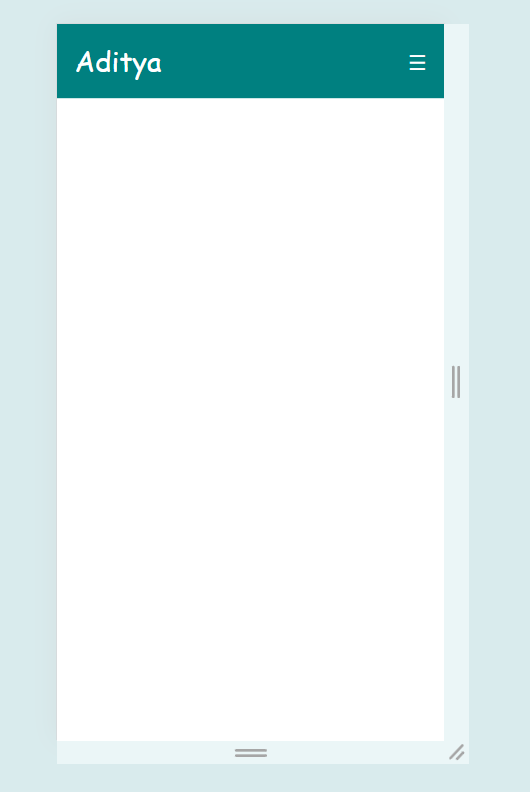
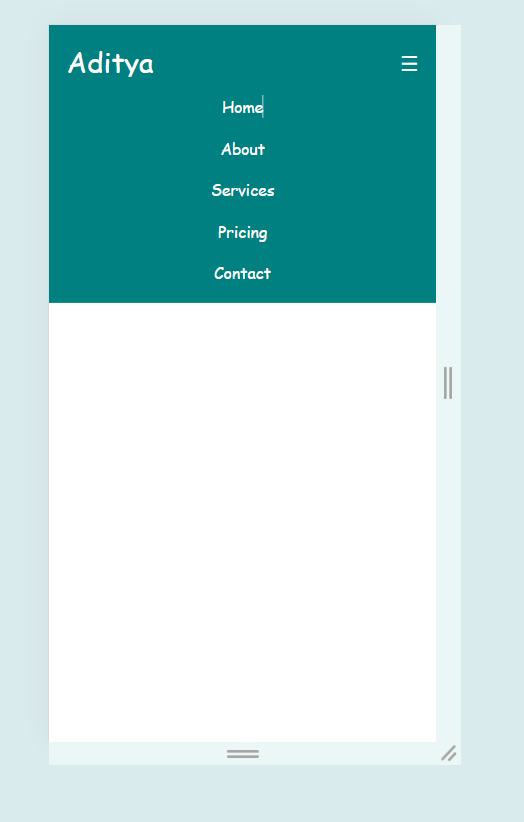
| Code By | Aditya Gadhave |
| Language Used | HTML And CSS |
| Responsive | Yes |
Conclution :
Having good website navigation heavily impacts bounce rates and conversion rates. Essentially, the first fold of your website should have a clear context, hierarchical navigation, and a call to action.
Subscribe to my newsletter
Read articles from Aditya Gadhave directly inside your inbox. Subscribe to the newsletter, and don't miss out.
Written by

Aditya Gadhave
Aditya Gadhave
👋 Hello! I'm Aditya Gadhave, an enthusiastic Computer Engineering Undergraduate Student. My passion for technology has led me on an exciting journey where I'm honing my skills and making meaningful contributions.